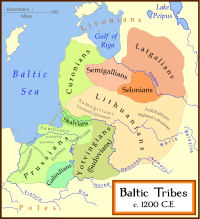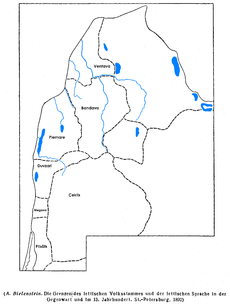- Curonians
-
- The Kursenieki are also known as Curonians.
The Curonians or Kurs (Curonian: Kursi; German: Kuren; Latvian: kurši; Lithuanian: kuršiai; Estonian: kuralased; Polish: Kurowie) were a Baltic[1] tribe living on the shores of the Baltic sea in what are now the western parts of Latvia and Lithuania from the 5th to the 16th centuries, when they merged with other Baltic tribes. They gave their name to the region of Courland (Kurzeme), and they spoke the Old Curonian language. Curonian lands were conquered by the Livonian Order in 1266 and they eventually merged with other Baltic tribes participating in the ethnogenesis of Lithuanians and Latvians. Direct descendants of the Curonians include the Kuršininkai of the Curonian Spit and the so-called Curonian Kings of Courland.
Contents
Curonians and the Livonian crusade
During the late iron age, the Curonians started to move from southern Courland to the north, assimilating a Finno-Ugric people who lived in the coastal regions of northen Courland. They then formed a new ethnic group, the so-called Curonised Livonians''.
There are many sources that mention the Curonians in the 13th. century, when they were involved in the northern crusades. In 1210 the Curonians, with eight ships, were attacked by a German crusader fleet in the Baltic sea, near the coast of Gotland. The Curonians were victorious and German sources claim that 30 crusaders were killed. Also in July 1210, the Curonians attacked Riga, the main crusader stronghold in Livonia. A huge Curonian fleet arrived in the mouth of the Daugava and besieged the city. However, after a day of fighthing, the Curonians were unable to break through the city walls. They crossed to the other bank of the Daugava to burn their dead and mourn for three days. Later they lifted the siege and returned to Courland.[2]
In 1228, the Curonians together with the Semigallians again attacked Riga. Although they were again unsuccessful in storming the city, they destroyed a monastery in Daugavgriva and killed all the monks there.
In 1230 the Curonians in the northern part of Courland, under their chief Lamekins (Lammechinus Rex), signed a peace treaty with the Germans, and the lands they inhabited thus became to be known as Vredecuronia or Peace Courland. The southern Curonians, however, continued to resist the invaders.
In 1260, the Curonians were involved in the Battle of Durbe, one of the biggest battles in Livonia in the 13th. century. The Curonian and Estonian armies refused to take part in the battle, as they had been forced to fight on the crusader side, and that allowed the Samogitians to gain victory over the Livonian order. It was a heavy defeat for the Order and uprisings against the crusaders soon afterwards broke out in the Curonian and Old-Prussian lands.[3]
Curonian resistance was finally subdued in 1266, when the whole of Courland was partitioned between the Livonian order and the Archbishop of Riga.
Historic sources about the Curonians
The Curonians were known as fierce warriors, excellent sailors and pirates. They were involved in several wars and alliances with Swedish, Danish, and Icelandic Vikings.[4] Grobin (Grobiņa) was their main centre during the Vendel Age. Chapter 46 of Egils Saga describes one Viking expedition by the Vikings Thorolf and Egill Skallagrímsson in Courland. They took part with the Oeselians in attacking Sweden's main city Sigtuna in 1187. Curonians established temporary settlements near Riga and in overseas regions including eastern Sweden and the islands of Gotland and Bornholm. The Curonians had a strong warrior culture and were related to Old-Prussians and are considered to be western-Baltic people.
The Curonians were an especially religious people, worshipping pagan gods and their sacred animal, the horse. Some of the most important written sources about the Curonians are Rimbert's Vita Ansgarii, the Chronicle of Henry of Livonia, the Livländische Reimchronik, Egils Saga, and Saxo Grammaticus's Gesta Danorum.
Administrative division
Bishop Rimbert of Bremen (lived before 888 AD) in his life of St. Ansgar, Vita Ansgarii described the territory inhabited by the Curonians (Cori) and gave the names of the administrative districts or lands (civitates):
- Vredecuronia or Vanemane was the land in the northeast of Courland, today in the district of Talsi.
- Wynda or Ventava was the land around the mouth of the river Venta, today in the district of Ventspils.
- Bandowe (Bandava) south of Vindava, is today in the district of Kuldīga.
- Bihavelanc or Piemare, also south of Bandava, is today in the district of Liepāja.
- Powsare (Dovsare) or Duvzare was a land further south in Courland, today in the district of Liepāja.
- Megowa or Megava (mentioned also as Negouwe in chronicles) 500 km², was in the environs of modern Palanga, Kretinga and Šventoji.
- Pilsaten or Pilsāts was the smallest region of around 200 km², in the western part of modern Klaipėda district and northwestern part of Šilutė district.
- Ceclis or Ceklis – the largest land of 1500 km² west of the Venta River in Samogitia, up to the Lithuanian-Latvian border.
Sources and references
- ^ Matthews, W. K. "Nationality and Language in the East Baltic Area", American Slavic and East European Review, Vol. 6, No. 1/2 (May, 1947), pp. 62-78
- ^ Chronicle of Henry of Livonia
- ^ Chronicle of Henry of Livonia
- ^ Matthews, W. K. "Medieval Baltic Tribes". American Slavic and East European Review, Vol. 8, No. 2 (Apr., 1949), pp. 126-136.
External links
Categories:- Baltic peoples
- Baltic Finns
- Ethnic groups in Europe
- History of Latvia
- History of Prussia
- History of Lithuania
Wikimedia Foundation. 2010.


